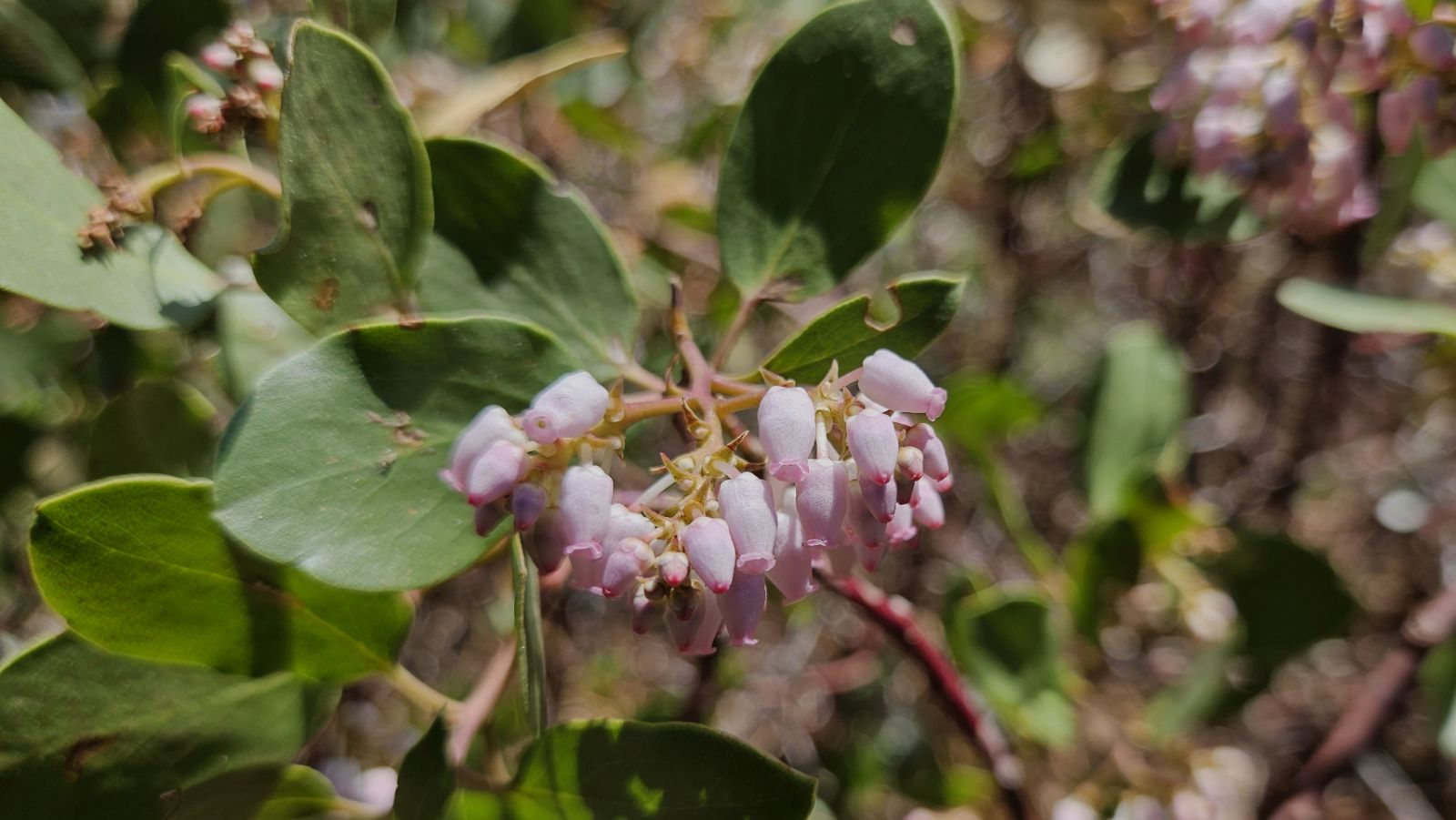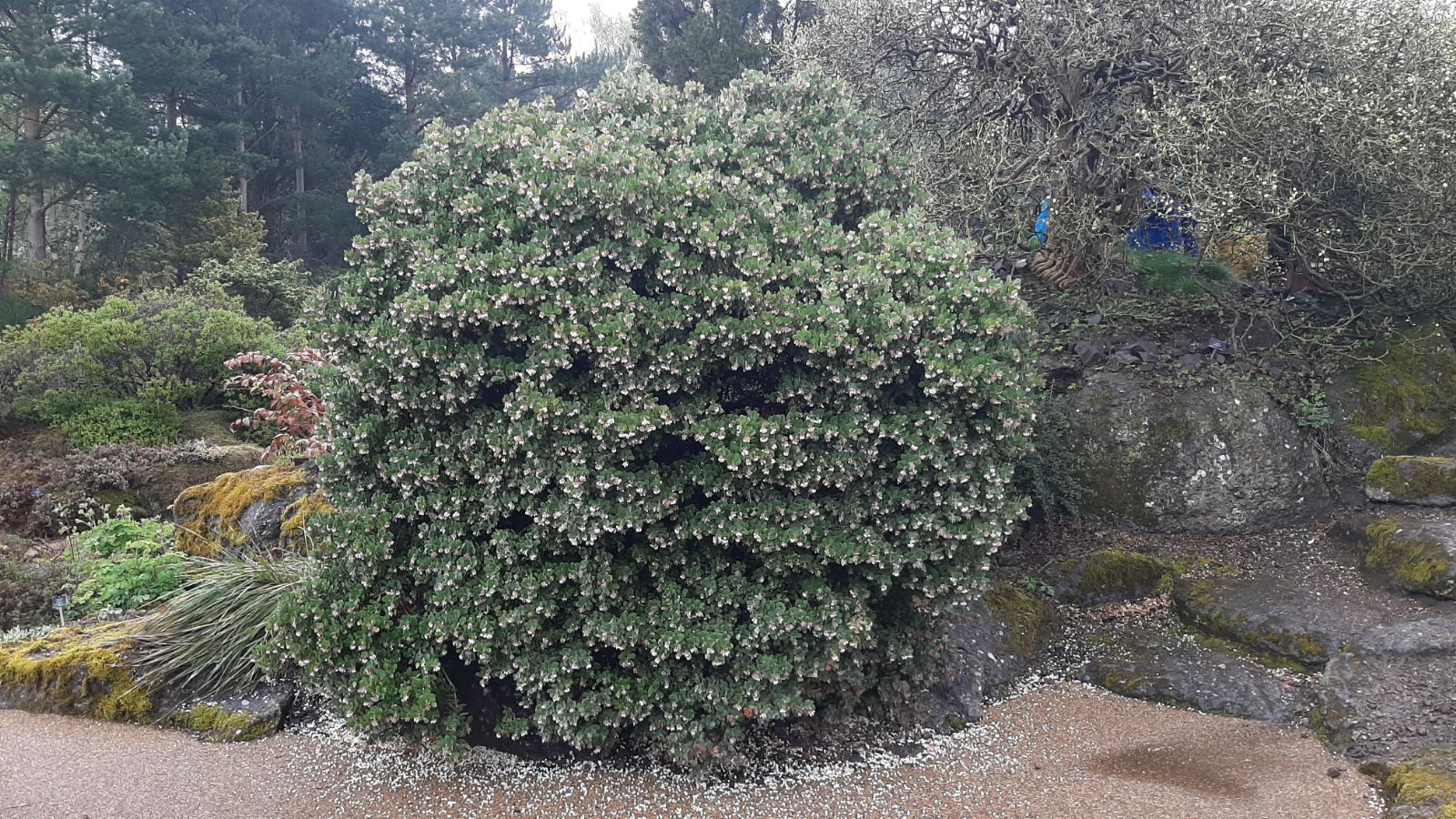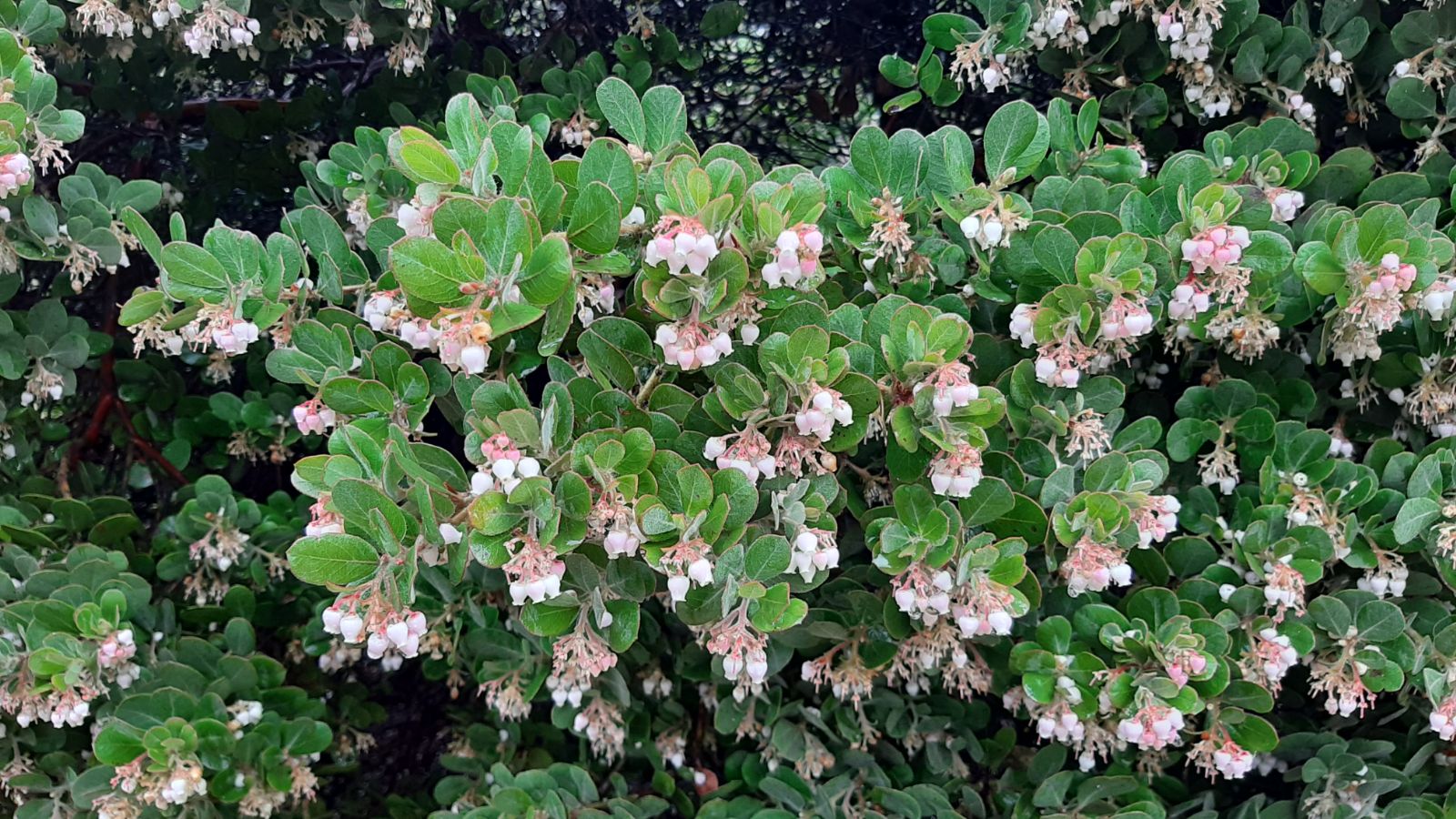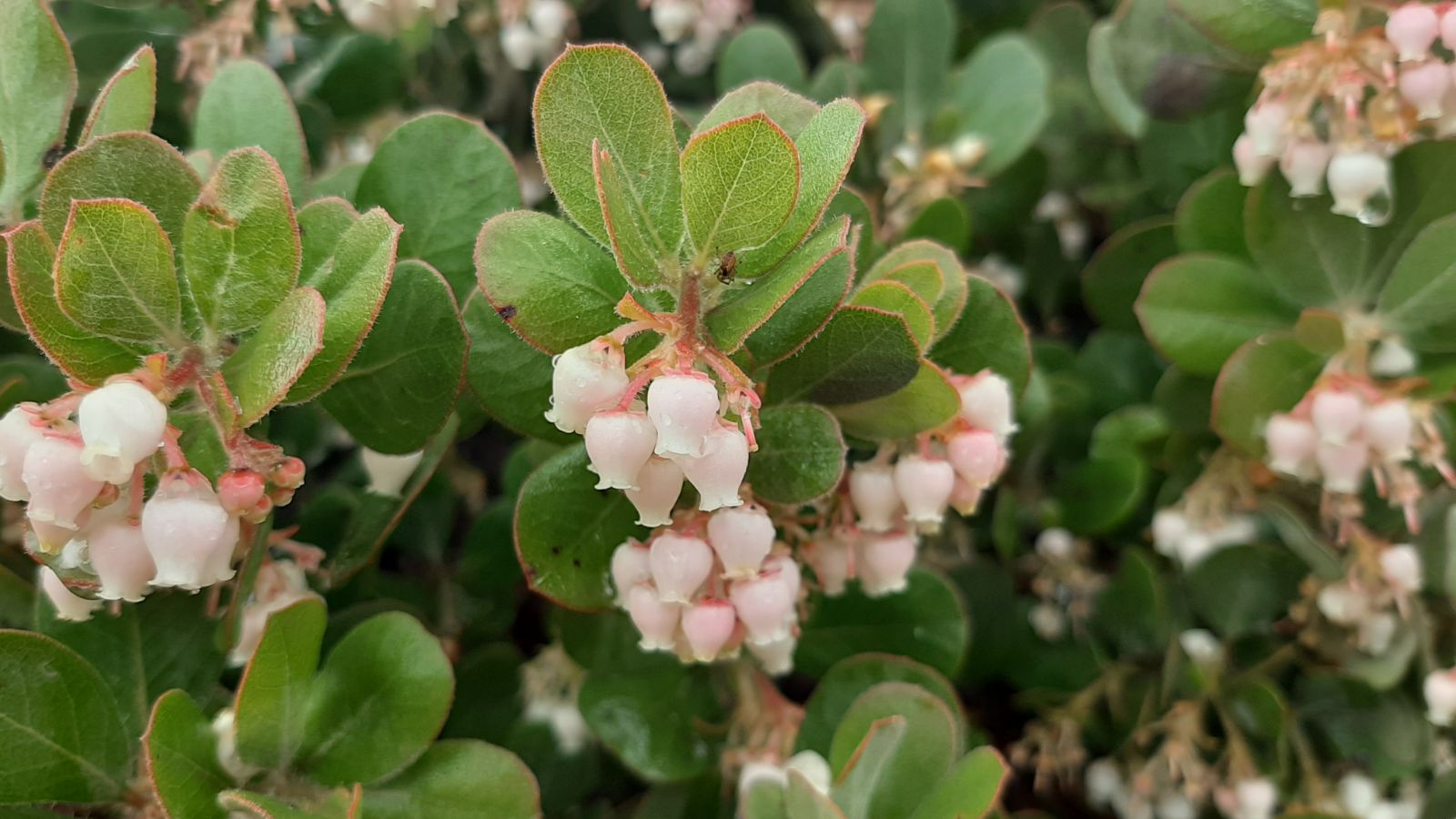Arctostaphylos uva-ursi
Credits
Article from Bean's Trees and Shrubs Hardy in the British Isles
Recommended citation
'Arctostaphylos uva-ursi' from the website Trees and Shrubs Online (treesandshrubsonline.
Infraspecifics
A trailing evergreen shrub, sending out long, slender, leafy branches, but rising only a few inches above the ground; young shoots glabrous or furnished with a minute down. Leaves leathery, obovate, rounded or retuse at the apex, with a long, tapering base, 1⁄2 to 11⁄4 in. long, 1⁄4 to 1⁄2 in. wide; bright green on both sides; margins hairy when young, otherwise glabrous; stalk 1⁄4 in. or less long. Flowers produced from April onwards in small, drooping, terminal clusters; corolla pitcher-shaped, 1⁄6 in. long, white or pink; ovary glabrous. Fruit globular, 1⁄4 to 1⁄3 in. in diameter, red, smooth and shining.
Native of the cooler temperate regions of the northern hemisphere, both in the New and the Old Worlds, found in diverse soils and habitats. It is equally at home on limestone and siliceous rock and is a vigorous coloniser of screes, boulders, and freshly exposed soils. It is an inhabitant mainly of mountains and sub-arctic forest, but is also found in dry pine forest, as in N. Germany and the eastern coast of N. America. In California, the headquarters of the genus Arctostaphylos, it is said to be confined to the coast, its place in the mountains being taken by A. nevadensis.
The American plants differ in having the branchlets more persistently downy than in the Eurasiatic form, and are sometimes distinguished as var. coactilis Fern. & Macbr.
In gardens, the bearberry is useful for forming a low evergreen ground-cover, its spreading masses of green foliage and small pinkish flowers being always pleasing. It may also be planted on the top of upturned tree-roots, which it will eventually completely drape, or on the top of miniature declivities of the rock garden. It is easily propagated by cuttings.
From the Supplement (Vol. V)
† cv. ‘Rax’. – Completely prostrate, with leaves smaller than normal. The original plant was found growing on the Raxalpe in eastern Austria, and the clone was put into commerce by Messrs Zwijnenburg of Boskoop (Dendroflora No. 13/14, p. 67 (1977)).
† A. ‘Wood’s Red’. – Of American origin, this received an Award of Merit on Oct. 9, 1973, for its large and bright red fruits, as a cultivar of A. uva-ursi, though its taxonomic position is uncertain. It is quite prostrate.
A. × media – Although hybrids between A. uva-ursi and A. columbiana are often identified as A. × media Greene, some authorities consider that the type belongs to A. uva-ursi.
A. nevadensis – The relationship of this species is considered by some authorities to be with A. pungens and A. manzanita, even though these are of much taller growth. It has indeed been made a suspecies of the former – A. pungens subsp. nevadensis (Gray) J. B. Roof. Another character distinguishing A. nevadensis from A. uva-ursi, in addition to the foliage, is that its berries are brownish red.
A. hookeri – Synonym: A. uva-ursi subsp. hookeri (G. Don) J.B. Roof.
A. edmundsii – This was considered by James Roof to be a natural hybrid between A. uva-ursi and A. rosei (mentioned above under A. crustacea as var. rosei).
A edmundsii JT Howell
A low shrub to about 2 ft high but eventually 10 ft or more across, with freely rooting stems. Branchlets with spreading hairs. Leaves about 1 in. long, ovate, elliptic or rounded, blunt and mucronate at the apex; upper surface without stomata. Flowers pink, in small compact inflorescences. Fruit brown. A recently described species, found only at the mouth of the Little Sur River, Monterey Co. This is by all accounts the finest of the dwarf manzanitas though probably tender.A hookeri G. Don
Branchlets downy. Leaves light lustrous green, shortly pointed or mucronate, with stomata on both surfaces, broadest below the middle (broadest above the middle in A. nevadensis). Fruit red. Confined to the coastal part of Monterey Co.A × media Greene
The plant so named was found in the state of Washington and is thought to be a hybrid between A. uva-ursi and A. Columbiana. It differs from the former in its larger leaves, downy beneath. Other plants have been found on the coast of western N. America, e.g. on Vancouver Island, which appear to be hybrids of this parentage.A myrtifolia Parry
Synonyms
A. nummularia var. myrtifolia (Parry) Jeps
A nevadensis Gray
A procumbent or prostrate shrub closely allied to A. uva-ursi. The main mark of difference is that the leaves have numerous stomata on both sides and a mucronate apex, whereas in A. uva-ursi the stomata are found only on the under-surface and the apex is blunt or retuse. It is a mountain plant of the Coast Range and the Sierra Nevada, California.There are several other low-growing species in cultivation, all natives of California and best suited when trailing over rocks in full sun. In the following brief account mention is made only of those characters by which they may be distinguished from each other and from the preceding species.
A nummularia Gray
Usually prostrate or procumbent, but sometimes erect to 4 or 5 ft high. Branchlets downy. Leaves dark lustrous green, without stomata on the upper surface. Calyx lobes four, stamens eight; ovary downy. Fruit greenish. A coastal species.A pumila Nutt
Branchlets downy. Leaves dull green, obovate, downy beneath, without stomata on the upper surface. Calyx lobes five, stamens ten. Fruit brown. Found only around Monterey Bay. It is tender.The following species may not have been introduced as yet, but is worthy of trial:





